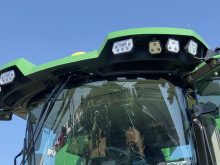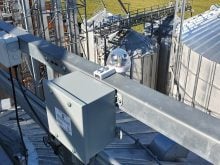The Baker Cross Slot opener is a radical New Zealand design that a handful of researchers and a few daring North American farmers have tried.
One of the pioneers is Cliff Merchant, a farmer from Falher, Alta., who bought 37 Cross Slots and installed them on a used Flexi-Coil 6000 toolbar bought for the purpose.
Merchant pulled off the wings to turn the toolbar into a 30-foot frame. He then stripped the Barton openers to install the Cross Slots on 10-inch row spacings. After two seasons of seeding, Merchant said the imported openers work better than anything he’s tried.
Read Also

Agritechnica Day 3: Hybrid drive for a combine, data standards keep up to tech change and tractors of the year
Agritechnica 2025 Day 3: Hybrid drive for a combine, data standards keep up to tech change and tractors of the year.
Viewed at the soil level from the front or back, the Cross Slot opener is an inverted letter “t. with a blade passing through the middle. The tiny tip of the “t” is a 22-inch notched coulter. The two arms are the blades, one for seed and one for fertilizer. The blades run tight against the coulter.
As this mechanism cuts along under ground, the two static blades slice horizontal slots in the soil, giving it the name Cross Slot.
The seed arm deposits seed below its horizontal blade, and the fertilizer arm deposits fertilizer below its horizontal blade. The coulter running between the two blades serves as a divider that keeps seed and fertilizer from mixing.
The coulter runs 2.5 inches deeper than the side blades, so it effectively cuts the straw without hairpinning. This lets Merchant cut his straw at a maximum height for the best snow catch and better combine efficiency.
The left and right blades attach to the opener arm separately. Both sides are available in three lengths, allowing the owner to vary the depth of seed and fertilizer according to soil conditions. This also lets the owner assemble the exact seed-fertilizer separation that he needs.
Each opener assembly is mounted on its own parallel link arm, controlled by individual hydraulic cylinders, which are cushioned by nitrogen accumulators. Each opener arm has 18 inches of vertical movement. The hydraulic system maintains constant pressure throughout that range.
Down force is measured by four load cells installed on the front opener row. These readings are averaged so hydraulic pressure is automatically adjusted as soil conditions change. The operator in the cab sets the amount of down force. Maximum down force is 1,500 pounds.
With the variety of openers available from North American companies, especially the high quality equipment from western Canadian manufacturers, why would a farmer go to all the trouble of importing that much iron from the other side of the globe?
“Because I just couldn’t find openers I was happy with,” Merchant said.
“We happened to be down in that corner of the world a few years back, and I saw these openers. I had a meeting with the Cross Slot people. I was pretty impressed, so I decided to give them a try.
“This year I seeded canola into five-year-old timothy sod. The seeding part of it worked very well. Then it froze two or three times, but that’s not the fault of the openers. We averaged 30 bushels per acre on those fields.”
Merchant said the Cross Slot rig has seeded and banded without problems into stubble from pea, canola, wheat and timothy. Rather than put down fertilizer when planting peas, he seeds down both sides to create a paired row.
Expensive purchase
If a product is expected to work right the first time, straight out of the box, it usually has a high price tag. And so it is with the Cross Slot openers, Merchant said.
“They’re very expensive. It works out to about $4,000 for each row by the time it all arrives here. I can see why. Each unit weighs 260 lb. Lots of steel and they’re very well built. Everything has either needle roller bearings or tapered roller bearings. There are no bushings anywhere. The openers are designed for 10,000 hours of operation.”
Cross Slot said its design target was 10,000 hours because that fits the typical life expectancy of a tractor in New Zealand. Seeding rigs in that part of the world generally work constantly nine months of the year, putting in two crops annually. Consequently, New Zealand farmers place a high priority on reliability.
Merchant said the New Zealand engineers had already fitted their system to some Flexi-Coil 6000 frames in Washington state, so it was no problem for them to build a set of 37 specifically for his Flexi-Coil.
Another expense is horsepower and fuel because Merchant figures there’s a fairly heavy draft load. He said he’s pulling six to eight horsepower per opener at 6.25 m.p.h., running a little less than one inch in seed depth in his heavy clay soils.
On the other hand, he said, the openers are giving him excellent depth control and placement, even at that speed. The inverted T blades reach out about an inch and a half side-to-side. The variety of blades available for each side let him adjust seed and fertilizer placement.
“The first year I put the longer blades on the fertilizer side because I was putting down ammonia. So the anhydrous was an inch or so to the side and about three quarters of an inch deeper than the seed just deep enough to stop vapour loss. There were no burning problems.
“This year I went to dry fertilizer, so I installed the fertilizer blade that’s even with the seed blade. Right now I’ve got the medium depth blades on both sides.
“But like any style of opener, the deeper you go, the more soil you disturb and the more moisture you lose.”
Blade options
Merchant said he still has the option of trying the third set of blades – the shallow ones. When he bought the opener arms, he ordered different blade configurations and spares to give different options.
“Each Cross Slot blade is only $25, so it’s no big expense to set yourself up with the full range of blades.”
Merchant said the paired depth control packer wheels are easy to adjust. They close up the slot and return the residue so well that it’s sometimes difficult to find where he is in the field if he’s looking for the seeded row.
“You do need autosteer and GPS because once you’ve made your pass, it really seals up the earth. You can get lost if you’re depending on the seed row to guide you.”
For more information, contact Cliff Merchant at 780-837-8136 or visit www.crossslot.com.















